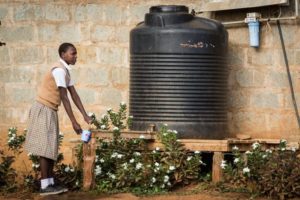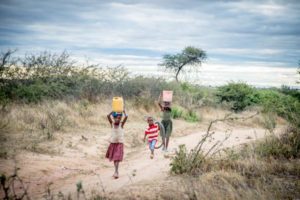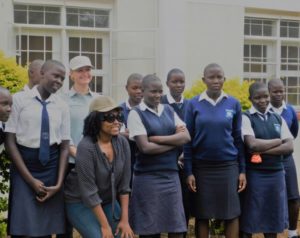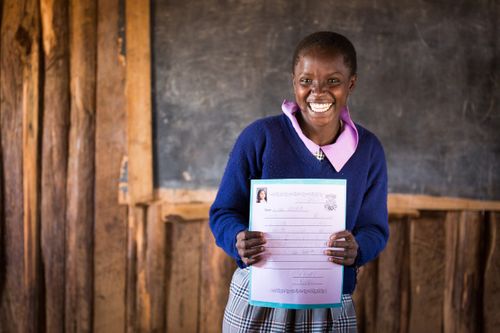June 6, 2019
Education: A Crisis For Water-Scarce Communities
It’s that time of year already. Families, college students, and teachers around the world are happily wrapping up the school year, anxiously awaiting that final bell. Yet, while many are understandably ready for a break from school, children in East Africa and beyond are hoping for another hour in the classroom.
Lack of clean water is one of the biggest factors preventing learning opportunities. That means for children in water-scarce areas, access to clean water can make or break their education. Imagine missing hours of school each day so that you can hike miles to a river to collect unclean water for your family. Imagine sitting in a classroom trying to take in all the information being taught, while in pain from diarrheal disease. Think about attempting to produce your first complete sentence with dizziness, headaches, and extreme fatigue looming over you. This is what many of these children experience, if they are fortunate enough to even make it onto school grounds.
According to the CDC, 2,195 children die each year due to diarrheal diseases. Let that sink in. More children are dying from preventable waterborne diseases, than from AIDS, Malaria, and Measles combined. And, if children are fortunate enough to have good health, their parents may not be. Due to the spread of fatal waterborne and other types of diseases in adults, many children become orphans. This leaves them with the responsibility to work to provide food and care for themselves or their siblings. To provide more children the opportunity to even walk through school doors, we have to ensure equal access to clean water and sanitation. It’s that simple. Water is the flood gate to all the opportunities awaiting these children.
In 2017, Well Aware drilled a new well in Olmoran, Kenya. John Kimathi, Head of the Olmoran High School, explains the effect clean water has had on education in just two years:
 “The borehole had instant impact on student population and improved grades at Olmoran high, primary, nursery, and special schools. Eg..in Olmoran High students were 400 in 2017, but has since increased to 616 at the beginning of 2019, and the trend is the same in the other schools.
“The borehole had instant impact on student population and improved grades at Olmoran high, primary, nursery, and special schools. Eg..in Olmoran High students were 400 in 2017, but has since increased to 616 at the beginning of 2019, and the trend is the same in the other schools.
Nine students, among them three girls, joined Kenyan universities with many more joining Diploma and Certificate colleges compared to much lower figures before 2017.”
Through Olmoran’s story and many others, we know access to clean water has a direct impact on education. It also has a direct impact on all other barriers preventing access to educational opportunities.
According to the UNICEF, these are the top barriers to education:
- Health and nutrition
- Poor quality environment
- Cost of materials
- Crises and instability
- Poor quality processes
- Poor quality content
Due to the burdens communities in water-scarce regions are faced with, like the ones mentioned above, education greatly suffers.
 For example, many children in our partner communities in East Africa are forced to take extended breaks from class in order to walk long distances to hydrate at ponds or other unsanitary water resources. These walks take away from valuable learning time. Often, the water they worked so hard to get leaves them sick at home and missing out on more educational opportunities. Girls are especially likely to miss school once they hit puberty. Rarely do schools provide a private sanitary area for girls to clean themselves during monthly cycles, pushing them to stay at home. Culturally, girls are also expected to take care of the household and make the long treks to water resources daily. This further prevents them from accessing school curriculums and leads to higher dropout rates for female students.
For example, many children in our partner communities in East Africa are forced to take extended breaks from class in order to walk long distances to hydrate at ponds or other unsanitary water resources. These walks take away from valuable learning time. Often, the water they worked so hard to get leaves them sick at home and missing out on more educational opportunities. Girls are especially likely to miss school once they hit puberty. Rarely do schools provide a private sanitary area for girls to clean themselves during monthly cycles, pushing them to stay at home. Culturally, girls are also expected to take care of the household and make the long treks to water resources daily. This further prevents them from accessing school curriculums and leads to higher dropout rates for female students.
Below are just a few of the many areas this lack of education can impact:
- Security
- Home Stability
- Community Wellbeing
- Economic Growth
- Social Structures & Gender Equality
- Poverty Levels
- Employment Opportunities
- Overall Community Development
With limited education, the poverty cycle continues. In order to break this cycle, it is critical to have clean water available so kids can attend school more regularly, and so that higher quality school systems can develop and grow. These school systems can improve the areas mentioned above firsthand. Clean water provides the opportunity to learn, which leads to improvements in economic growth, security, home stability, and so much more.
Once at school, many children in our partner communities in East Africa are taking extended breaks from class and walking long distances to hydrate at ponds or other unsanitary water resources. These walks take away from valuable learning time. Often, the water they worked so hard to get leaves them sick at home and missing out on more educational opportunities. Girls are especially likely to miss school once they hit puberty. Rarely do schools provide a private sanitary area for girls to clean themselves during monthly cycles, pushing them to stay at home. Culturally, girls are also expected to take care of the household and make the long treks to water resources daily. This further prevents them from accessing school curriculums and leads to higher dropout rates for female students.
In Ratta, Kenya, a girl’s hostel experienced the direct educational impact of water. Previously, the 50 girls from the Ratta Girl’s Hostel would travel three kilometers to the governor’s home to borrow water. The girls would leave at 6 pm after school to fetch water every day and come back at 9 pm. They could only manage to bring back one pail of water each, because of the long distance they travel. Not only did this severely restrict their water usage, and therefore their ability to stay healthy and clean, but it also severely limited their time to study.
 Before Well Aware was able to implement a clean water system in their community in 2017, only a couple of girls from the hostel were able to make it to university each year. Now, with reliable access to clean drinking water and more time to study, six more girls went on to higher education in 2018.
Before Well Aware was able to implement a clean water system in their community in 2017, only a couple of girls from the hostel were able to make it to university each year. Now, with reliable access to clean drinking water and more time to study, six more girls went on to higher education in 2018.
Now, the girls from the hostel, and the entire Ratta community, can wash, clean, and drink water as often as they need to. They now have more time to focus on studying, and the positive implications on their future success are tremendous.
So, as we wrap up the school year and eagerly head into summer, we must not forget that around the globe, children are missing opportunities to grow and learn because of a lack of this vital resource. These children may be the next group to advocate for climate change, the next scientists to cure cancer, or the next teachers. They may be what the world needs to bring about unity. So, let’s give them the opportunity to try by providing clean water.
Sources:
https://www.cdc.gov/healthywater/global/diarrhea-burden.html
https://thewaterproject.org/why-water/education
https://habitatforhumanity.org.uk/blog/2017/04/poverty-and-education-east-africa/
